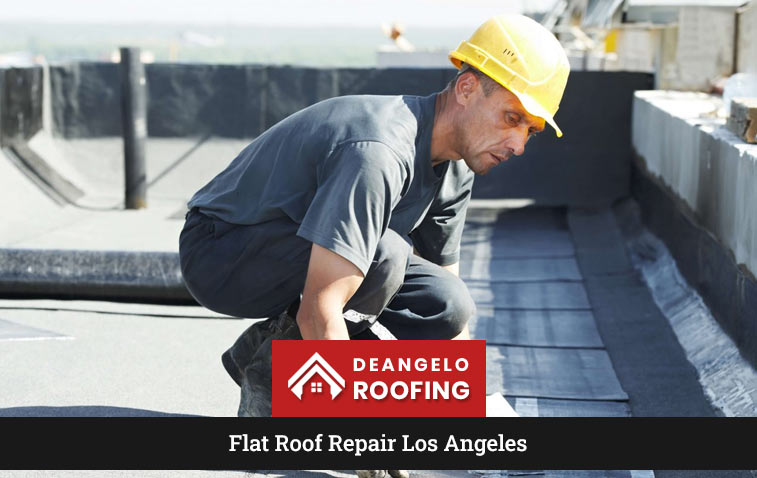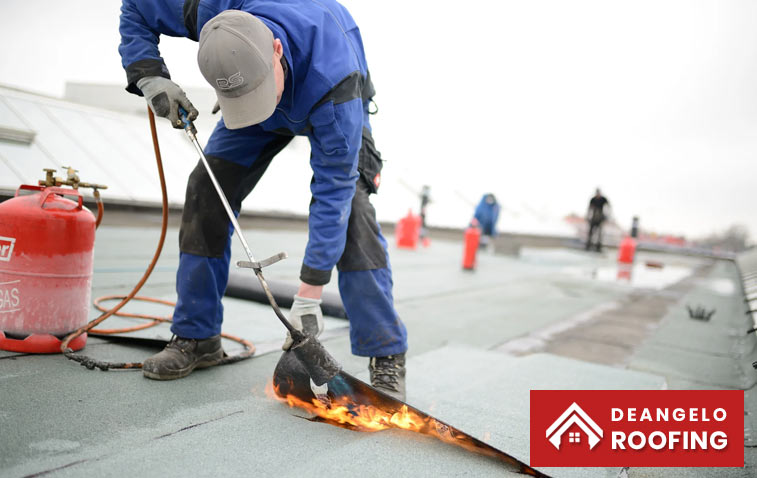Flat Roof Repair and Maintenance: A Guide
Living in the bustling city of Los Angeles means enduring its unique climate, which can be tough on flat roofs. The intense sun, occasional heavy rains, and urban pollution contribute to wear and tear that can lead to leaks and having to repair flat roof Los Angeles.
Detecting flat roof leak repair Los Angeles involves watching for signs like water pooling, leaks, discoloration, cracks, and odors. Regular maintenance includes clearing debris, checking for defects, inspecting flashing, and ensuring proper insulation. Perform these routines twice a year to prevent damage and costly repairs.

Finding the Flat Roof Leak Repair
Identifying the exact point of a leak in your flat roof is the first crucial step in the Los Angeles flat roof leak repair process. Often, the visible signs of leakage inside your property do not precisely align with the spot on the roof where water penetrates.
To locate leaks, visually inspect the roof for obvious signs of damage, such as cracks, blisters, or punctures. Water pools, an all too common sight on flat roofs, especially after a rainstorm, can indicate problematic areas.
If an internal water stain matches a troubled spot on the roof, you’re looking at a prime suspect. For the residents of Los Angeles, timely flat roof leak repair is imperative to avoid the damage that comes with the city’s occasional but intense downpours. If the task proves to be overwhelming, consider calling in the experts from Deangelo Roofing to ensure precise detection and professional repair.
Roof Repair Materials
- EPDM, aka Rubber
A popular synthetic rubber roofing membrane is known for its durability and flexibility. Made from ethylene, propylene, and diene, it is resistant to UV rays, ozone, and chemicals. With a lifespan of up to 50 years, EPDM is a single-ply membrane that is relatively easy to install and repair.
- Modified bitumen
Asphalt roofing is made with a blend of asphalt, polymers, and other modifiers. It is more flexible and durable than traditional asphalt roofing and is available in various colors. Modified bitumen is typically installed in two or three layers and lasts up to 20 years.
- BUR (Built roofing), aka roofing tar and gravel roofing
A traditional type of roofing made with multiple layers of asphalt and roofing felt. The top layer is typically covered with gravel or slag. BUR is a very durable roofing system lasting up to 30 years. However, it is also the most expensive and difficult to install of the roofing materials listed here.
- TPO Roofing
A single-ply roofing membrane made from a blend of polypropylene and ethylene. It is white or light gray and is highly reflective of UV rays. TPO is resistant to chemicals and oils and can last up to 20 years. It is also relatively easy to install and repair.
- PVC Roofing
Another type of single-ply roofing membrane. It is similar to TPO but is slightly less flexible. PVC is available in various colors and is resistant to chemicals and fire. It can last for up to 20 years. However, PVC is less environmentally friendly than TPO and can be more difficult to install.
What Causes A Flat Roof Leak?
Multiple factors contribute to flat roof leaks, and understanding these can be key to prevention and timely repairs. Firstly, age is a significant factor, as materials break down over time, increasing the likelihood of leaks. A flat roof in Los Angeles is particularly susceptible to damage from intense UV rays, which can cause roofing materials to deteriorate more quickly than in less sunny climates.
Poor installation and workmanship can also leave your roof vulnerable to water infiltration. For example, water can seep through these weak points if the roofing material is not properly sealed at joints or around protrusions, such as vents or air conditioning units.
Water pooling is another common culprit, often resulting from inadequate drainage. In Los Angeles, even though heavy rains are infrequent in Los Angeles, they can lead to significant standing water that cannot evaporate quickly under the persistent sun, leading to seepage and damage over time.
Lastly, debris and structural damage, such as punctures from foot traffic or falling branches, can compromise the integrity of a flat roof, allowing water to enter. Regular inspections and maintenance can identify and rectify such issues before they escalate into major leaks.
Flat Roof Repair Los Angeles Options
When exploring options to repair flat roof in Los Angeles, homeowners and property managers have several approaches to consider depending on the type and severity of the damage.
Patching with compatible roofing material is often sufficient for minor punctures or tears. However, a more comprehensive approach might be necessary if the roof has extensive damage or is nearing the end of its service life.
A complete roof replacement could be the most cost-effective long-term solution in cases of significant deterioration. If the structural integrity is still intact, a roof coating or overlay can extend the life of the roof without the need for a total replacement.
For those who prefer professional services to repair flat roof in Los Angeles, it is important to hire our licensed roofing contractors experienced in dealing with the specific challenges of maintaining and repairing flat roofs in the region. This ensures that any repairs are performed accurately, comply with local building codes, and can withstand the unique weather conditions of the area.
Flat Roof Repairs vs Flat Roof Replacement Options
Choosing between flat roof repair or replacement depends on the extent of damage and your budget.
Repair is ideal for small issues like punctures, flashing leaks, or minor membrane tears. Patching, sealing, or applying a roof coating can address these problems cost-effectively. However, extensive damage, widespread leaks, nearing lifespan (15-20 years for most materials), or outdated roof systems warrant a replacement.
This involves removing the old roof and installing a new membrane, addressing any underlying problems like insulation or drainage. While more expensive upfront, replacement offers long-term peace of mind and improved energy efficiency.
Cost to Repair Flat Roof vs. Flat Roof Replacement in Los Angeles
In Los Angeles, the cost of repairing a flat roof versus replacing it entirely hinges on the severity of the damage and the size of your roof. Let’s break it down:
Flat Roof Repairs:
- Small fixes: Punctures, minor leaks, or tears typically cost $200-$500 to patch or seal.
- Moderate repairs: Replacing membrane sections or addressing flashing issues can range from $500 to $2,000.
- Extensive repairs: If over 25% of the roof needs fixing, the cost might reach $3,000-$5,000, nearing replacement territory.
Flat Roof Replacement:
- Los Angeles averages: Expect to pay $4,000-$5,000 for a 1,200 sq ft roof replacement.
- Material matters: EPDM is more affordable, while PVC or metal roofs can cost $7,000-$10,000.
- Additional factors: Permits, disposal fees, and complex roof structures can add $1,000-$3,000 to the bill.
How To Keep Your Los Angeles Flat Roof Last Long
To maximize the longevity of your Los Angeles flat roof, it’s imperative to:
- Keep the drains clear; ensuring drains are unobstructed will prevent water pooling.
- Prune overhanging branches; removing potential debris sources helps minimize physical damage.
- Inspect the roofing periodically; regular checks can identify minor issues before they escalate.
- Inspect the flashing consistently; checking for integrity can avert water penetrating the roof system.
Conclusion
Understanding and addressing the myriad factors contributing to flat roof leaks is essential for preserving the integrity and longevity of your property in Los Angeles. Regular maintenance, prompt flat roof leak repair Los Angeles, and choosing the right professionals for repairs and replacements are critical to safeguarding your investment. Proper care and informed decision-making will ensure that your flat roof withstands the unique climate of Los Angeles, providing reliable protection for years to come.
FAQ About Flat Roof Repairs
Due to their lack of slope and increased exposure to the elements, flat roofs require more regular inspections and maintenance. Aim for biannual inspections and prompt repairs to address any issues early on.
Green roofs offer insulation, improved air quality, and stormwater management benefits. However, they require specialized waterproofing layers, drainage systems, and ongoing maintenance to ensure the roof’s integrity.
It depends on the cause of the damage. Weather events covered by your policy offer some coverage, while wear and tear due to age typically wouldn’t be covered. Check your specific policy details.

